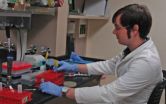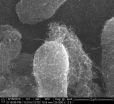(Press-News.org) When competing for food and resources, bacteria employ elaborate strategies to keep rival cells at bay. Scientists have now identified a pathway that allows disease-causing bacteria to attack other bacterial cells by breaking down their cell wall.
Pseudomonas aeruginosa is a type of bacteria readily found in everyday environments. It easily forms colonies in a wide variety of settings, including medical devices, body organs and skin wounds. This allows it to cause disease and act as a major pathogen, particularly in hospitals.
Research led by Joseph Mougous, assistant professor of microbiology at the University of Washington in Seattle, provides new insight into how P. aeruginosa acts as a master colonizer and maintains a competitive advantage over other bacteria. The study, which will be published in the July 21 issue of the journal Nature, describes how P. aeruginosa uses a specialized secretion system--the type VI secretion system--to deliver toxic proteins to recipient opponent bacteria. These proteins break down a structural protein known as peptoglycan, which the authors describe as "an Achilles heel of bacteria." Degrading this target in turn causes the breakdown of the protective cell wall of competitor bacteria. Furthermore, P. aeruginosa protects itself from this attack by using specific, strategically localized immunity proteins that counteract the effects of the toxic proteins it secretes.
This discovery not only sheds light on P. aeruginosa's pathogenic success, but is also interesting from an evolutionary perspective as it highlights the functional similarity between the bacterial type VI secretion system and viruses that infect bacteria, or bacteriophages.
INFORMATION:
This research was supported by the National Institutes of Health, the European Commission within the DIVINOCELL programme, and the National Science Foundation.
For more information regarding this research, view the video sound bites of Alistair Russell, lead author of the research manuscript and National Science Foundation Graduate Research Fellow at the University of Washington.
Bacterial attack strategy uses special delivery of toxic proteins
Pseudomonas aeruginosa targets opponents' cell walls and immunizes itself against its own weapons
2011-07-22
ELSE PRESS RELEASES FROM THIS DATE:
Blue collar workers work longer and in worse health than their white collar bosses
2011-07-22
While more Americans are working past age 65 by choice, a growing segment of the population must continue to work well into their sixties out of financial necessity. Research conducted by the Columbia University's Mailman School of Public Health and the University of Miami Miller School of Medicine looked at aging, social class and labor force participation rates to illustrate the challenges that lower income workers face in the global marketplace. The study used the burden of arthritis to examine these connections because 49 million U.S. adults have arthritis, and 21 ...
Chronic pain in homeless people not managed well: Study
2011-07-22
TORONTO, Ont., July 21, 2011—Chronic pain is not managed well in the general population and it's an even greater challenge for homeless people, according to new research by St. Michael's Hospital.
Twenty-five per cent of Canadians say they have continuous or intermittent chronic pain lasting six months or more. The number is likely to be even higher among homeless people, in part due to frequent injuries.
Of the 152 residents of homeless shelters with chronic pain studied by Dr. Stephen Hwang, more than one-third (37 per cent) had Chronic Pain Grade IV, the highest ...
Nanotechnology for water filter
2011-07-22
This release is available in German.
Nanotechnology has developed tremendously in the past decade and was able to create many new materials with a vast range of potential applications. Carbon nanotubes are an example of these new materials and consist of cylindrical molecules of carbon with diameters of a few nanometers – one nanometer is one millionth of a millimeter. Carbon nanotubes possess exceptional electronic, mechanical and chemical properties, for example they can be used to clean polluted water. Scientists of the University of Vienna had recently published ...
Fingerprinting fugitive dust
2011-07-22
This release is available in Spanish.
Each community of soil microbes has a unique fingerprint that can potentially be used to track soil back to its source, right down to whether it came from dust from a rural road or from a farm field, according to a U.S. Department of Agriculture (USDA) soil scientist.
Ann Kennedy, at the Agricultural Research Service (ARS) Land Management and Water Conservation Research Unit in Pullman, Wash., studies the biological properties of soils that affect wind erosion. She analyses the soil for the fatty acid or lipid content from the community ...
Study: Subsidizing wages at long-term care facilities would cut turnover
2011-07-22
CHAMPAIGN, Ill. — Subsidizing the wages of caregivers at group homes would likely reduce worker turnover rates and help contain costs at long-term care facilities, according to new University of Illinois research.
Elizabeth T. Powers, a professor of economics and faculty member of the Institute of Government and Public Affairs at Illinois, says that a government-sponsored wage-subsidy program could reduce the churn of low-wage caregivers through group homes by one-third.
"High rates of worker turnover have costs, and there aren't a lot incentives for the agencies that ...
Stronger social safety net leads to decrease in stress, childhood obesity
2011-07-22
CHAMPAIGN, Ill. — Social safety net programs that reduce psychosocial stressors for low-income families also ultimately lead to a reduction in childhood obesity, according to research by a University of Illinois economist who studies the efficacy of food assistance programs on public health.
Craig Gundersen, a professor of agricultural and consumer economics at Illinois, says food and exercise alone are not to blame for the extent of obesity among children in the United States. Psychosocial factors, such as stressors brought about by uncertainty about the economy, income ...
Executive pay reform unlikely to reduce systemic risk in economy
2011-07-22
CHAMPAIGN, Ill. — Reforms aimed at curbing executive compensation will likely have little effect on reducing systemic risk in the financial system, and they may even have unintended consequences for the freedom to contract, according to a University of Illinois expert in business law and corporate finance.
In a paper published in the Ohio State Entrepreneurial Business Law Journal, law professor Christine Hurt argues that giving regulators unprecedented power to prohibit certain types of private compensation under the guise of minimizing systemic risk in the financial ...
Study: Regulatory hurdles hinder biofuels market
2011-07-22
CHAMPAIGN, Ill. — Regulatory hurdles abound for the successful commercialization of emerging liquid biofuels, which hold the promise of enhancing U.S. energy security, reducing greenhouse gas emissions and serving as a driver for rural economic development, according to new U. of I. research.
In the study, University of Illinois law professor Jay P. Kesan and Timothy A. Slating, a regulatory associate with the University of Illinois Energy Biosciences Institute, argue that regulatory innovations are needed to keep pace with technological innovations in the biofuels industry.
"Getting ...
Chance favors the concentration of wealth, U of M study shows
2011-07-22
Most of our society's wealth is invested in businesses or other ventures that may or may not pan out. Thus, chance plays a role in where the wealth of a society will end up.
But does chance favor the concentration of wealth in the hands of a few, or does it tend to level the playing field? Three University of Minnesota researchers have built a simplified model that isolates the effects of chance and found that it consistently pushes wealth into the hands of a few, ever-richer people.
The study, "Entrepreneurs, chance, and the deterministic concentration of wealth," ...
NASA sees Tropical Storms Bret and now Cindy frolic in North Atlantic
2011-07-22
Two tropical storms are now in the open waters of the North Atlantic: Bret and Cindy. Both were captured on one image from NASA today. Both storms are hundreds of miles to the east-northeast of Bermuda and pose no threat to land areas.
NASA's GOES Project issued an infrared image of both Bret and Cindy today from the GOES-13 satellite, which is operated by NOAA. The NASA GOES Project is housed at NASA's Goddard Space Flight Center in Greenbelt, Md. and uses GOES-13 data from NOAA to create images and animations. The image was captured at 0845 UTC (4:45 a.m. EDT) and shows ...
LAST 30 PRESS RELEASES:
NASA’s Webb telescope finds bizarre atmosphere on a lemon-shaped exoplanet
The gut bacteria that put the brakes on weight gain in mice
Exploring how patients feel about AI transcription
Category ‘6’ tropical cyclone hot spots are growing
Video: Drivers struggle to multitask when using dashboard touch screens, study finds
SLU research shows surge in alcohol-related liver disease driving ‘deaths of despair’
Rising heat reshapes how microbes break down microplastics, new review finds
Roots reveal a hidden carbon pathway in maize plants
Membrane magic: FAMU-FSU researchers repurpose fuel cells membranes for new applications
UN Member States pledge to increase access to diagnosis and inhaled medicines for the 480 million people living with COPD
Combination therapy shows potential to treat pediatric brain cancer ATRT
Study links seabird nesting to shark turf wars in Hawai‘i
Legal sports betting linked to sharp increases in violent crime, study finds
Breakthrough AI from NYUAD speeds up discovery of life-supporting microbes
New Eva Mayr-Stihl Foundation funding initiative boosts research at University of Freiburg on adaptation of forests to global change
The perfect plastic? Plant-based, fully saltwater degradable, zero microplastics
Bias in data may be blocking AI’s potential to combat antibiotic resistance
Article-level metrics would provide more recognition to most researchers than journal-level metrics
Satiety’s little helper: Protein that supports appetite regulating protein identified
UF dives deep into predicting storm damage with computer models
A stormy ocean voyage yields insights on the global carbon cycle
Scientists identify first non-coding gene that controls cell size
Demonstration of altermagnetism in RuO₂ thin films -- A new magnetic material for the AI era
Penn researchers awarded $25M to conduct trial using smartphones to fight heart disease
PCORI awards funding for new patient-centered healthcare research
Exploring the origins of the universe: 145 low-noise amplifiers complete ALMA telescopes
Empress cicada wings help illuminate molecular structure
Using sound waves to detect helium
Time burden in patients with metastatic breast and ovarian cancer from clinic and home demands
Researchers discover bias in AI models that analyze pathology samples
[Press-News.org] Bacterial attack strategy uses special delivery of toxic proteinsPseudomonas aeruginosa targets opponents' cell walls and immunizes itself against its own weapons






